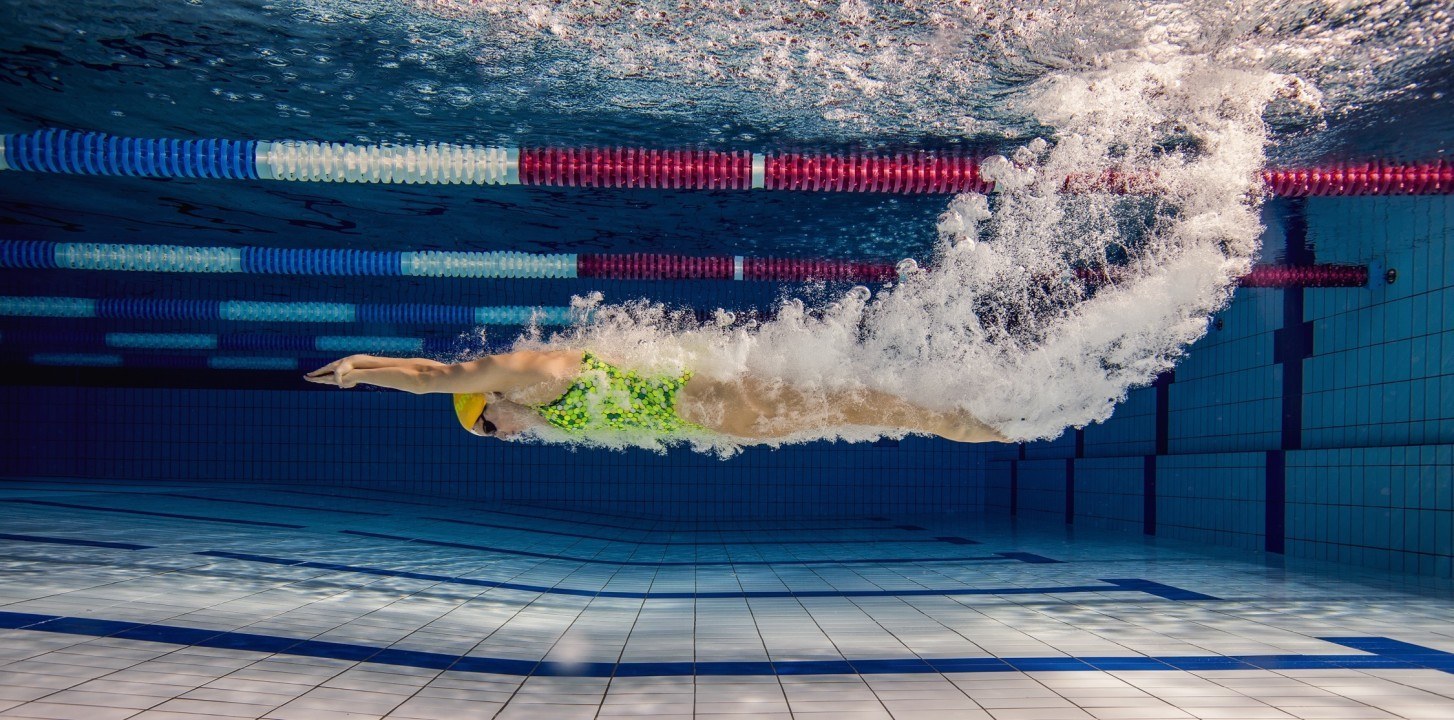Courtesy of Jenni Brozena, MS, CSCS, CES
Shoulders get most of the attention from the swimming and medical community as the number one problem/complaint/downfall of being a swimmer. Swimmers posture also has an equally bad reputation, classified commonly as having “upper-crossed syndrome” with a forward head, rounded shoulder position. This posture, combined with the repetitive overhead motion of the sport, only further promotes the downfall of shoulder health in swimming.
What about the glutes?
The gluteal muscles, also known collectively as “the glutes”, are your butt muscles. These three muscles are incredibly important in pelvic stability, hip stability, upright posture, and locomotion. For ground sports that have high ACL injury rates, much research has been performed in order to fully understand gluteal firing, strength training, and rehabilitation protocols in order to better promote necessary hip stability for successful athletic movement. Less research has been done to fully understand the involvement of the glutes in swimming.
Swimmers need “bilateral” strength, or both sides, of their hips in order to perform symmetrical body rolling, kicking, and ultimately propulsive stroke cycles. Water polo players must have control of their vertical posture and strong kicking in the constant abduction position. Both athletes need the pelvic stability to reduce excessive forces through their lumbar (lower back) spine region.
What are the gluteal muscles and what do they do?
1. Gluteus Minimus – Kicking away from your side and rotating your hip inward. In anatomical terms: abduction of the hip, preventing adduction of the hip and medial rotation of thigh.
2. Gluteus Medius – Kicking away from your side and rotating your hip outward. In anatomical terms: hip abduction, preventing adduction of the hip and lateral rotation of thigh.
3. Gluteus Maximus – Kicking behind you and rotating the hip outward. In anatomical terms: external rotation and extension of the hip joint, and supports knee extension.
Recent research in the Journal of Science and Medicine in Sport found differences in activation patterns within the gluteus minimus between non-elite and elite swimmers. While this research was performed with the swimmers walking, the findings are applicable to underwater analysis. Non-elite swimmers showed anterior segments of the gluteus minimus to peak earlier than the posterior sections, while elite swimmers had more equally timed activation. While this can be attributed to compensatory factors with the swimmers dealing with ground reaction forces, we can apply it easily to maladaptive movements in all of the strokes.
Identifying “gait dysfunction” in breaststrokers:
Breaststrokers will often complain of knee pain. Many swimmers receive conflicting cues that they should “whip” or “glide” their kick. If we reflect on the gluteal firing patterns as seen during underwater video analysis, we’ll find four instances when there is gluteal muscle dysfunction inhibits swimming performance:
1. Complaints of knee pain
2. Complaints of low back pain
3. Observed decreases in breaststroke performance
4. Observed lateral hip drop, commonly seen as zigzagging in the lane
In the underwater world of constant horizontal motion, this posture becomes the new “upright/vertical” so often studied in gate analysis. The glutes ability to stabilize a swimmer’s hips during breaststroke is the easiest clue to identify if the swimmer is suffering from a lack of activation or beginning to experience fatigue.
Just as we watch for changes in scapular positioning as a sign of fatigue in a youth baseball pitcher, we should look for changes in hip stabilization as a sign of fatigue in a swimmer.
So how can sport scientists, performance coaches, physical therapists, and coaches teach swimmers to care about their glutes?
1. Educate that glutes are important in force production, swimming efficiency, injury prevention, and quick recovery from knee or low back pain.
2. Include easy glute activation exercises during developmental swimming including glute squeezes, hip extension, and abduction.
3. Cue swimmers that are “wiggling” in the lane to activate their glutes during the propulsive phase of the breaststroke kick.
Citation: Semciw, Adam and Rodney Green, et al. “Gluteal Muscle Function and Size in Swimmers”. Journal of Science and Medicine in Sport (2015), http://dx.doi.org/10.1016/j.jams.2015.06.004
About Jenni Brozena
Jenni Brozena is an international sport scientist and Owner/President of Aqueous, an international organization empowering actionable engagement between aquatic athletes, sport science, human performance, and healthcare. Aqueous is dedicated to the deliberate treatment of aquatic athletes through the performance continuum including preparation, performance, and rehabilitation.
 Website: www.aqueous.co
Website: www.aqueous.co
Twitter: @AqueousCo
Facebook: Aqueous Co
LinkedIn: Jenni Brozena
Jenni Brozena is a SwimSwam content partner.

Good article and a great reminder that we are not made from parts such as shoulder or pelvis. Professionals usually evaluates the body as a whole and start findings from ones foot. A reason for problems can usually be found somewhere else than where the problem exists. Gluteal inactivation is not all that rare “problem”. I would say that most adults have it, even tough they don’t know about it. Some people even might train with weights and think that they get good gluteal activation during squat, but normally it doesn’t transfer in any way to their everyday life such as walking. We should remember that every step that we make in life is a great exercise, not only the… Read more »
Very informative. I’d like to see more like this